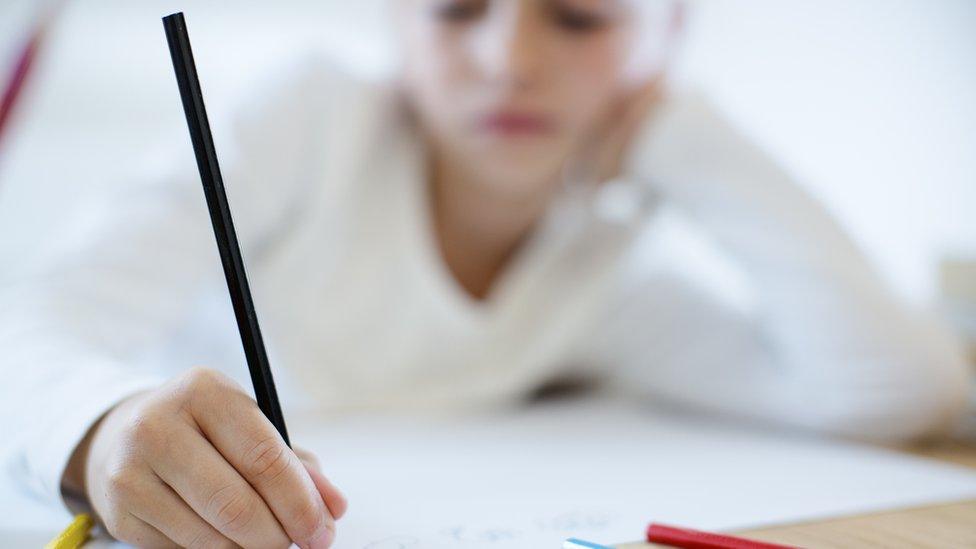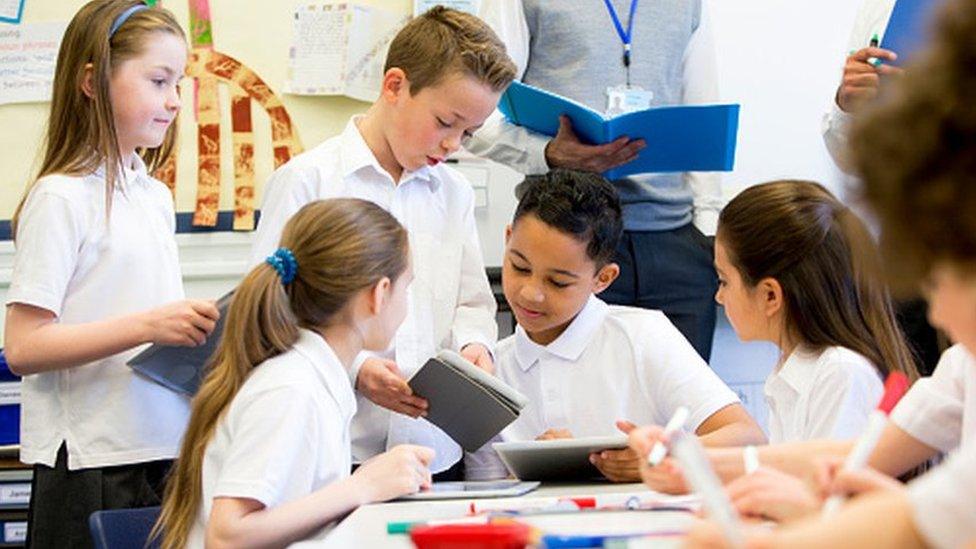Ignore school league tables, head teachers urge parents
- Published
- comments

Parents are being urged to ignore the latest school league tables, after "chaotic" changes to tests in England.
Final year primary pupils sat a raft of tough new tests in the summer. Only 53% of pupils passed, compared to the 80% who passed easier tests in 2015.
Primary heads leader Russell Hobby said ministers had stressed the scale of the changes meant comparisons could not be drawn on previous years' results.
The government said schools had responded well to the higher demands.
Pupils at 14,930 state primary schools sat the new national Sats tests in reading, writing and maths - the "Three-Rs"; they also sat a spelling and grammar test.
Schools are then ranked by these results to enable parents to narrow down the choice of schools for their children.
Join the conversation - find us on Facebook, external
In the run up to and during the tests, teachers and heads across England complained that the new papers had been set at too high a level and that not enough information had been made available.
The government's expectation is that 65% of pupils in each school should meet the new expected standard in the "Three Rs".
In total, about 11,000 schools failed to meet this target.
However, the Department for Education (DfE) said schools that achieved sufficient progress scores in reading, writing and maths would not be considered to be failing.
It had deliberately held steady the percentage of schools deemed to be failing at 5% - the same as last year - so that the volatility of this year's results did not lead schools that were otherwise successful to be targeted for intervention.

Conversely, just 47 schools saw all pupils reaching the expected standard in reading, writing and maths.
General secretary of the National Association of Head Teachers, Mr Hobby, said: "The pass mark for the test was set at a ridiculously high level.
"We have just failed half the children in the country and yet Ofsted is saying nearly 90% of schools are good or outstanding.
"Pupils were doing what they should have been doing in the early years of secondary school. Some of the grammatical stuff was the same level as GCSE English."
He added: "This data is not worth the paper it is written on. The government itself has said that it cannot be used to trigger interventions in schools.
"This year we saw the Sats system descend into chaos and confusion.
"Delayed and obscure guidance, papers leaked online, mistakes in test papers and inconsistent moderation made this year unmanageable for school leaders, teachers, parents and pupils."
But School Standards Minister Nick Gibb said the introduction of a new curriculum had raised expectations and ensured "pupils become more accomplished readers and are fluent in the basics of arithmetic, including times-tables, long division and fractions".
"Many schools have responded well to this more rigorous curriculum, supporting their pupils to be leaving primary school better prepared for the demands of secondary school," he said.

Last year, when four-fifths of school pupils reached the expected level, then known as Level 4C, ministers praised schools for "rising to the challenge of raised standards and expectations for all pupils".
Boys v girls
Julie McCulloch, primary specialist at the Association of School and College Leaders, said schools had "performed miracles" in very difficult circumstances and deserved great credit.
"The tests are based on a new, much harder curriculum, which the children had followed for only two years, and the expected standard has been significantly raised.
"In addition, the government's introduction of these tests has been chaotic."
The data shows a continuing gender gap, with 57% of girls reaching the expected level in reading, writing and maths compared with 50% of boys.
And the most disadvantaged children fared far worse in these new tests, compared to their non-disadvantaged peers, than they did in the previous test with just 39% achieving the standard.
The government data also reveals regional differences, with London performing very strongly.
Sorry, your browser cannot display this map
Of the top 10 ranking local authorities, in terms of the expected standard in reading, writing and maths, nine are in London.
Of the 33 London boroughs, all but one (Enfield) was above the national average in terms of the expected standard in reading, writing and maths.

The five local authorities with the highest percentage of pupils making the grade:
Kensington and Chelsea 70%
Bromley67%
Richmond-upon-Thames 67%
Trafford 66%
Sutton 65%
The five local authorities with the lowest percentage of pupils making the grade:
Bedford 42%
Peterborough 43%
Luton 45%
Dorset 45%
Stoke-on-Trent 45%

Ludgvan School in Cornwall was the only school where more than 50% of students achieved a high score in reading and maths and were working at greater depth in writing.
As well as test result data, the school league tables also provide lots of information about schools' social make-up, teaching workforce and the historic trend in their results.
- Published15 December 2016

- Published5 July 2016
